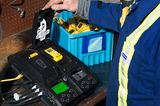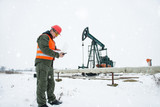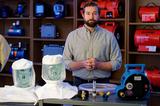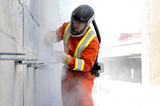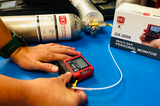Blog
How to Properly Fit and Adjust a Fall Arrest Harness
Wearing and adjusting a fall arrest harness is an important part of your job if you plan on working above ground level, such as on the side of a tower, ledge, or elevated platform. Everyone on your team should feel confident about putting on and adjusting their harness to prevent accidents and falls on the job. Knowing how to properly adjust a harness will also help your team stay comfortable, so they can do their jobs safely and efficiently.
Learn more about basic fall protection safet
…
Nov 21st 2019
How to Re-Calibrate a Gas Detector - Gas Detector Calibration
There are lots of different options to consider when
re-calibrating a gas monitor. Every gas detector is different, so re-calibrating all depends on what kind of monitor you’re working with.
Re-calibration is essential when it comes to the health and safety of your employees.
Gas monitors typically need to be re-calibrated every six months, according to The Occupational Safety and Health Administration (OSHA). You’ll also need to bump test your equipment regularly t
…
Nov 19th 2019
New Wildfire Emergency Regulations Issued by the CAL/OSHA
Wildfires continue to wreak havoc throughout California and beyond. In response to the latest round of wildfires, California and the Occupational Safety and Health Administration (OSHA) have enacted an emergency regulation that’s meant to protect outdoor workers from potentially dangerous wildfire smoke. It’s not just firefighters who have to worry about breathing in various toxins and smoke. Gardeners, landscapers, construction workers, and anyone else who has to be outside as part of their job
…
Nov 12th 2019
How to Layer FR Clothing
Temperatures are dropping as we head into the winter months. If your employees work with or near potential fire and arc flash hazards, you’ll need to protect your team and keep them warm at the same time. This usually means layering flame resistant (FR) clothing. FR clothing comes in all shapes and styles, but one garment may not be enough when it comes to staying warm in the field. For the purpose of this article, we are lumping Fire and Arc Flash hazards together as 'fire hazards'.
If
…
Nov 7th 2019
Respirator for Beards: Which Respirators Are Facial Hair Friendly?
It’s almost No Shave November, or Movember as it’s often called, and that means many of your male employees may be sporting facial hair in the weeks to come. Some of your employees may already have thick beards and mustaches, but all that extra hair can be a hazard for those that need to wear respirators on the job, including those that work in construction, mining, and manufacturing. Your employees must wear respirators on the job when exposed to hazardous chemicals and airborne compounds, r
…
Oct 31st 2019
Safety Vest Classes: What’s the Difference Between Class 1, 2, and 3 Safety Vests?
When your team is in the field, your workers need to wear safety vests, or high-visibility vests. These vests are made with highly reflective materials that keep individual workers visible, especially at night. All safety vests are rated and approved by the American National Standards Institute (ANSI). Safety vests are classified as Class 1, Class 2, or Class 3, based on the amount of both reflective material and high contrast (orange or lime color) fabric making up the vest. The degree of re
…
Oct 22nd 2019
Silica Dust Mask: What Type of Respirator Should I Use for Silica?
We make specific recommendations below, but first a little background. Working in the manufacturing or construction industries often means being exposed to what’s known as silica dust, or respirable crystalline silica, which is created by cutting, grinding, drilling, or crushing stone, rock, concrete, brick, mortar, and other construction materials. Silica dust poses a direct and serious threat to the health of anyone working near this dust. A study by Koo et al. (2000) highlighted the significa
…
Oct 17th 2019
Calibration Gas Shelf Life: Do Calibration Gases Have a Shelf Life?
When using a gas monitor, it’s important to make sure your monitor is properly calibrated, otherwise your readings may be inaccurate. To properly calibrate your monitor, you’ll need to use a concentration of the gas you’re trying to detect. The test gas typically comes in disposable or nonrefillable cylinders that either made of steel or aluminum. This is also known as a calibration gas or span gas, but these gases have a shelf life. You’ll need to replace your calibration gases according to
…
Oct 14th 2019
Gloves For Oil: What Are the Best Gloves for the Oil and Gas Industry?
The oil and gas industry can be a dirty business; you and your team will need a set of reliable safety gloves before you get to work. Before you buy just any pair of work gloves, it’s important to choose safety gloves that were designed for your particular industry and the task at hand. Without the proper gear, your employees will be vulnerable to a range of hazards and toxic chemicals. Learn more about selecting the right gloves for gas and oil from the safety equipment experts at PK Safety.
…
Oct 8th 2019
How to Administer a Respirator Fit Test?
As an employer, it’s your responsibility to fit test respirators on your workers, so everyone has access to reliable safety equipment. According to OSHA safety standard 1910.134, employers are required to teach their employers respiratory safety, including how to put on a respirator, how to position it on the face, and how to determine if the respirator fits properly. If you've never performed a respirator fit test, keep reading to learn more.What Is a Respirator Fit Test?The test is designed to
…
Oct 3rd 2019



